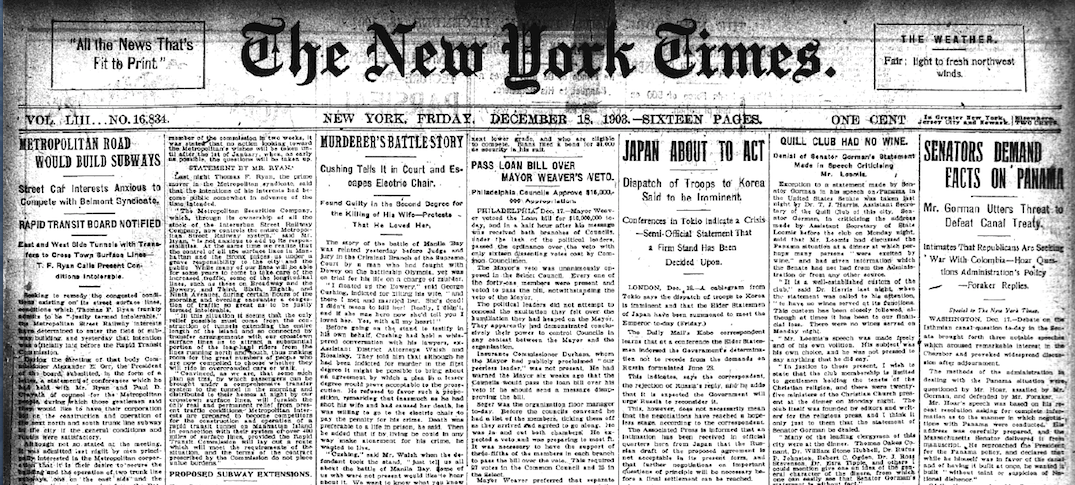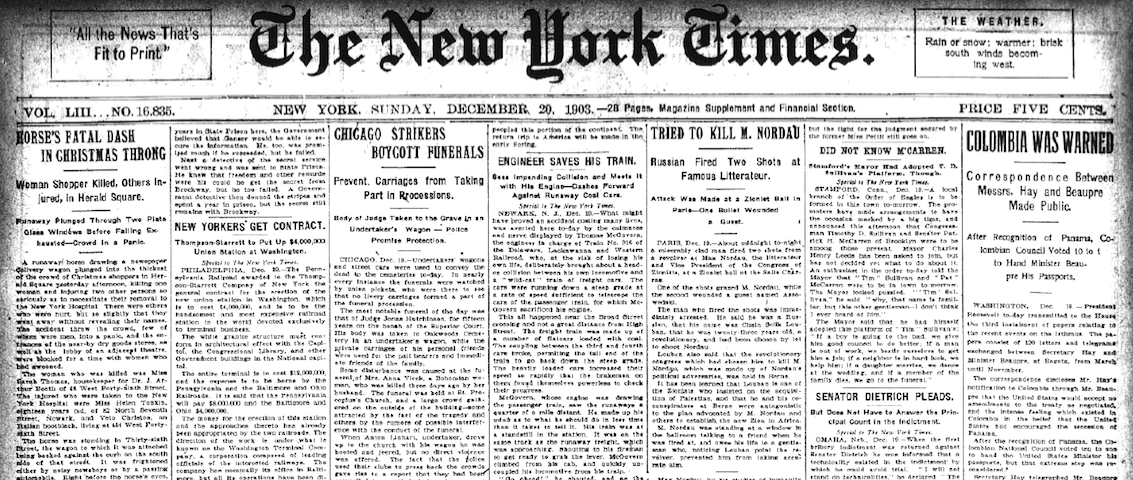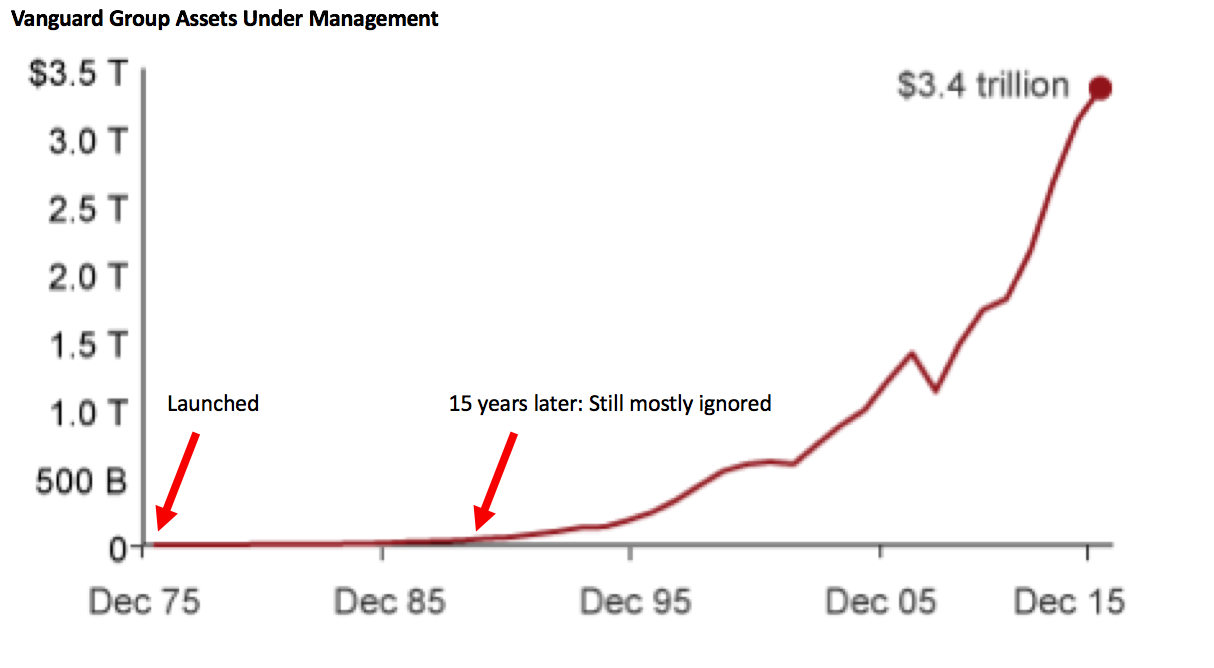When you changed the world, and no one noticed
- Transfer
Do you know what is happening in this photo? Literally one of the most important events in the history of mankind.

And the most amazing thing in this story is that at that time almost no one noticed it.
Brothers Wilbur and Orville Wright conquered flights on December 17, 1903. Few inventions have changed the world so much over the next century. Traveling by train from New York to Los Angeles took four days in 1900. By the 1930s, it could be done in 17 hours by air. By the 1950s in six hours.
Unlike, for example, decoding a genome, a lay person can immediately realize the miracle of flying for a person. A man sat in a box and turned into a bird.
But after a few days, months, and even years after the first Wright flight, almost no one noticed this.
Here is the first page of The New York Times the day after the first flight:

Not a word about Wright. Two days later - again nothing:

Three days later, when Wright made the fourth flight, which lasted almost a minute. Nothing:

And so on. Four days, five, six, six weeks, six months ... Not a single mention of people who conquered heaven for the first time in human history.
In the Library of Congress, where I found these newspapers, two interesting details were revealed to me. First, the first mention of Wright in The New York Times appeared in 1906, three years after their first flight. Secondly, in 1904, the newspaper asked the magnate of balloons if people could ever fly. He replied:

This was a year after the first flight of the Wright brothers.
In his 1952 book on American History, Frederick Lewis Allen wrote:
Wright's story shows a general principle: it often takes a lot of time from how you change the world, and before you manage to convince people that you changed the world.
Jeff Bezos once said:
This is a very important message. Things that get instant recognition are usually existing products with little change. We like them because they are familiar to us. The most innovative products - those that change the world - are usually never perceived immediately, even by the most intelligent people.
So it was with the phone. Alexander Graham Bell tried to sell his invention to Western Union, and received the answer:
So it was with the car. Twenty years before Henry Ford convinced the world that he was on the right track, Congress issued the following verdict:
This happened to the index fund, one of the most important financial innovations of the last 50 years. John Bogle launched the first index fund in 1975. No one attached any importance to him in the next twenty years. Popularity began to come to them gradually, in the 1990s. And then, three decades after the appearance, the idea spread like a fire.

This is happening now. 3D printing has been actively developing in the last five years. But this is not a completely new invention. Look at this interview with the director of 3D Systems as early as 1989.
3D printers, like many inventions, have a delay of several decades between invention and adoption. Same thing with solar energy. Photovoltaics was opened in 1876. Commercial copies appeared in the 1950s, and Jimmy Carter placed solar panels on the White House in the 1970s. But they did not really take off until the end of the 2000s.
Big breakouts usually go seven steps.
• At first, no one heard of you.
• Then they heard about you, and decided that you were crazy.
• Then they understood your product, but decided that it has no future.
• Then your product is considered as a toy.
• Then your product is considered as an amazing toy.
• Then they begin to use it.
• Then without him they can’t imagine their life.
And this process can go on for decades. It rarely takes less than a few years.
Three conclusions can be drawn from this.
To change the world, you need to be a genius. But in order to wait for people to notice this, a completely different quality is needed. Zen patience is not usually associated with the image of an entrepreneur. But it is often required, especially for products that change the world.
If innovation is measured by generations, it is not necessary to measure results in quarters. History shows how long, chaotic and chaotic changes can take place. The stock market is a very funny story about how millions of people expect fast, accurate and clean solutions from current companies. The difference between reality and expectations explains frustration.
Invention is only the first step of innovation. Stanford professor Paul Saffo describes it this way:

And the most amazing thing in this story is that at that time almost no one noticed it.
Brothers Wilbur and Orville Wright conquered flights on December 17, 1903. Few inventions have changed the world so much over the next century. Traveling by train from New York to Los Angeles took four days in 1900. By the 1930s, it could be done in 17 hours by air. By the 1950s in six hours.
Unlike, for example, decoding a genome, a lay person can immediately realize the miracle of flying for a person. A man sat in a box and turned into a bird.
But after a few days, months, and even years after the first Wright flight, almost no one noticed this.
Here is the first page of The New York Times the day after the first flight:

Not a word about Wright. Two days later - again nothing:

Three days later, when Wright made the fourth flight, which lasted almost a minute. Nothing:

And so on. Four days, five, six, six weeks, six months ... Not a single mention of people who conquered heaven for the first time in human history.
In the Library of Congress, where I found these newspapers, two interesting details were revealed to me. First, the first mention of Wright in The New York Times appeared in 1906, three years after their first flight. Secondly, in 1904, the newspaper asked the magnate of balloons if people could ever fly. He replied:

“In a very, very distant future,” said the count, focusing on the word “very,” and shrugging his shoulders, hinting at eternity, “flying cars may appear, but not now, not now.”
This was a year after the first flight of the Wright brothers.
In his 1952 book on American History, Frederick Lewis Allen wrote:
Several years passed until the public realized what Wright was doing; people were so sure that flights were impossible, that most of those who saw them flying over Dayton in 1905 decided that this was some kind of trick that was not of particular importance - something like how people would perceive in our days, for example, telepathy. Only in May 1908, almost four and a half years after the first flight, experienced reporters were sent to see what the brothers were doing, experienced editors believed in joyful reports, and the world suddenly realized that the man’s flight successfully took place.
Wright's story shows a general principle: it often takes a lot of time from how you change the world, and before you manage to convince people that you changed the world.
Jeff Bezos once said:
An invention requires preparedness for the fact that you will not be understood for a long time. You do something that you believe in, of which you are convinced, but for a long time people with sincere intentions will criticize these attempts ... If you are really sure that they are wrong, you should be prepared for the fact that you will not be understood for a long time. This is a key point of the invention.
This is a very important message. Things that get instant recognition are usually existing products with little change. We like them because they are familiar to us. The most innovative products - those that change the world - are usually never perceived immediately, even by the most intelligent people.
So it was with the phone. Alexander Graham Bell tried to sell his invention to Western Union, and received the answer:
This “phone” has too many flaws to seriously take it as a practical form of communication. The device has no use for us. How can a company use this electric toy?
So it was with the car. Twenty years before Henry Ford convinced the world that he was on the right track, Congress issued the following verdict:
Horseless carriages driven by gasoline can reach speeds of 14, or even 20 miles per hour. The threat to people from such vehicles rumbling along our streets and roads, and poisoning the atmosphere, requires the rapid adoption of laws. The cost of producing gasoline is too high for private production ... In addition, the development of engines can damage the use of horses, which will destroy our entire agriculture.
This happened to the index fund, one of the most important financial innovations of the last 50 years. John Bogle launched the first index fund in 1975. No one attached any importance to him in the next twenty years. Popularity began to come to them gradually, in the 1990s. And then, three decades after the appearance, the idea spread like a fire.

This is happening now. 3D printing has been actively developing in the last five years. But this is not a completely new invention. Look at this interview with the director of 3D Systems as early as 1989.
3D printers, like many inventions, have a delay of several decades between invention and adoption. Same thing with solar energy. Photovoltaics was opened in 1876. Commercial copies appeared in the 1950s, and Jimmy Carter placed solar panels on the White House in the 1970s. But they did not really take off until the end of the 2000s.
Big breakouts usually go seven steps.
• At first, no one heard of you.
• Then they heard about you, and decided that you were crazy.
• Then they understood your product, but decided that it has no future.
• Then your product is considered as a toy.
• Then your product is considered as an amazing toy.
• Then they begin to use it.
• Then without him they can’t imagine their life.
And this process can go on for decades. It rarely takes less than a few years.
Three conclusions can be drawn from this.
To change the world, you need to be a genius. But in order to wait for people to notice this, a completely different quality is needed. Zen patience is not usually associated with the image of an entrepreneur. But it is often required, especially for products that change the world.
If innovation is measured by generations, it is not necessary to measure results in quarters. History shows how long, chaotic and chaotic changes can take place. The stock market is a very funny story about how millions of people expect fast, accurate and clean solutions from current companies. The difference between reality and expectations explains frustration.
Invention is only the first step of innovation. Stanford professor Paul Saffo describes it this way:
30 years is needed for a new idea to enter the culture. Technology does not push change. They are promoted by our joint reaction to the opportunities and prospects offered by technology.
